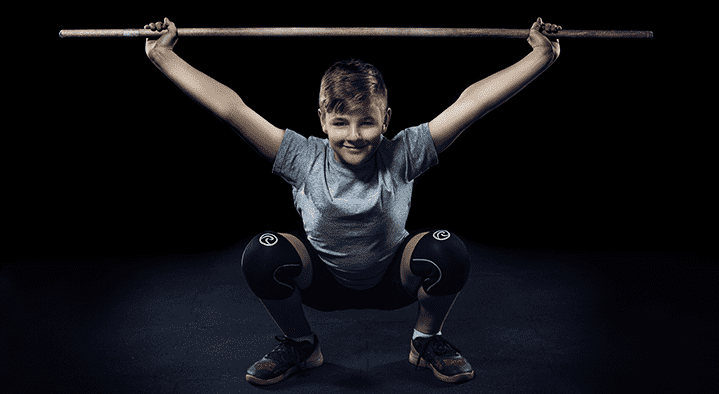In a world where childhood obesity rates are on the rise and sedentary lifestyles are becoming the norm, instilling a passion for fitness in our youth is more critical than ever. Youth strength and conditioning programmes are designed not only to promote physical well-being but also to instil healthy habits that can last a lifetime.
As scientific knowledge advances rapidly, it’s crucial to align youth strength and conditioning programmes with the latest research. Contrary to popular belief, resistance training can provide benefits to all populations regardless of age, and the adolescent stage is a crucial time for development where this training can have innumerable benefits.
Why Does Strength and Conditioning Matter for Kids?
Physical Health
- Increases bone density: Weight-bearing exercises promote bone growth, especially during crucial developmental years. Recent studies show resistance training’s positive impact on bone mass in young girls, reducing osteoporosis risk later in life (Lloyd et al., 2020).
- Improves body composition: Strength training builds lean muscle mass, leading to a healthier body composition and potentially aiding in weight management, especially when combined with cardiovascular exercise.
- Enhances cardiovascular health: While aerobic exercise reigns supreme for cardiovascular health, appropriate strength training can also contribute. Training may have positive effects on blood pressure and cholesterol levels in young athletes.
- Reduces injury risk: Stronger muscles and proper movement patterns gained through strength and conditioning training contribute to better stability and coordination, potentially reducing the risk of sports-related injuries.
- Improves sports performance: For young athletes, targeted strength and conditioning programs can significantly enhance speed, power, and agility, leading to improved performance in their chosen sports.
Mental Health
- Boosts self-confidence: Achieving strength and fitness goals can lead to a sense of accomplishment and increased self-efficacy, contributing to better self-esteem.
- Reduces stress and anxiety: Physical activity, including strength training, has been shown to reduce stress and anxiety levels in kids and teenagers.
- Improves overall well-being: The combined benefits of physical and mental health improvements contribute to a better overall sense of well-being and quality of life in young individuals.
Debunking Common Myths
Dispelling myths surrounding youth strength and conditioning is crucial for fostering a safe and effective approach to fitness. Recent scientific evidence has challenged several misconceptions, providing a clearer understanding of the benefits and risks associated with strength training for young individuals.
Myth 1: Lifting weights stunts growth.
The primary concern behind the stunted growth myth is the potential damage to growth plates, responsible for bone elongation during childhood. However, multiple studies have shown no harmful effects of resistance training on growth plates (Lloyd et al., 2016).
Instead of hindering growth, strength training can actually enhance bone density, a crucial factor for long-term health and athletic performance. Research suggests that training can put beneficial stress on bones which may increase strength and density.
Myth 2: Young individuals should avoid strength training and only perform bodyweight exercises.
When performed properly under the guidance of qualified coaches and within tailored training programmes, strength training is incredibly safe for young people. Studies show no significant increase in injury rates compared to other childhood activities (Faigenbaum et al., 2009). Proper technique, controlled movements, and appropriate weights minimise risk.
While bodyweight exercises are a great foundation, gradually introducing external weights offers further benefits. Begin with medicine balls and resistance bands before progressing to barbells, dumbbells, and kettlebells. These tools allow for progressive overload, which safely challenges muscles and promotes strength gains.
Myth 3: Young kids need to specialise in one sport if they want to become elite.
Early specialisation in one sport often neglects crucial aspects of athletic development, like fundamental movement patterns, coordination, and fitness skills. These are better nurtured through a variety of sports and activities in early years. Additionally, repetitive strain on the same muscles and joints due to early specialisation significantly increases the risk of overuse injuries, hindering progress and potentially derailing athletic careers.
Excessive focus on one sport at a young age can also lead to burnout, disenchantment, and abandonment of sports altogether. Studies show that athletes who specialise later in their teens or even early twenties can still achieve elite performance (Moran et al., 2023). Delaying specialisation allows for a broader foundation and better adaptability across sports.
Strategies for Success
Fundamentals First
- Prioritise Movement Mastery: Before lifting weights, focus on developing fundamental movement patterns through playful activities, games, and bodyweight exercises. This builds a solid foundation for future training and reduces injury risk.
- Focus on Quality Over Quantity: Proper technique is paramount, especially with younger athletes. Choose lighter weights and prioritise controlled movements for optimal muscle engagement and safety.
- Individualised Approach: Every child develops at their own pace and has unique needs. Tailor training programs to their age, maturity level, athletic goals, and individual abilities.
- Listen to the Body: Pay attention to fatigue cues and encourage rest and recovery. Pushing through pain can lead to injury.
Age Appropriate Training
- Playful Development (5-8 years old): Focus on fun and engaging activities like obstacle courses and games that naturally develop fundamental movement patterns. Organised sports leagues and weightlifting aren’t necessary at this stage.
- Basic Strength Training (9-12 years old): Introduce basic strength training exercises with light weights or bodyweight. Activities like squats, lunges, pushes, and pulls are perfect. Prioritise proper technique before increasing intensity.
- Progressive Overload (13-18 years old): Gradually increase training intensity and volume as the athlete matures and adapts. Utilise proper periodised training programs with varying intensities and recovery periods. Prioritise compound exercises (squats, deadlifts, lunges, rows, bench press etc.) which target multiple muscle groups simultaneously.
- Multi-Sport Participation: Encourage participation in various sports and activities throughout childhood. This fosters well-rounded development, reduces overuse injuries, and prevents burnout.
Example Training Session (9-12 years old)
| Order | Exercise | Sets x Reps | Rest Period |
| A1 | Goblet Squat | 3 x 10-12 | 1-2 mins |
| A2 | TRX Row | 3 x 12 | |
| A3 | Hollow Hold | 3 x 30 s | |
| B1 | Walking Lunge | 3 x 10 ES | 1-2 mins |
| B2 | Pushup | 3 x 10-12 | |
| C1 | Banded Pull Through | 3 x 10 | 1 min |
| C2 | Side Plank | 3 x 20 s ES |
Example Strength Training Session (13-18 years old)
| Order | Exercise | Sets x Reps | Rest Period |
| A1 | Bulgarian Split Squat | 3 x 8 ES | 2 mins |
| A2 | Standing Db Shoulder Press | 3 x 10 | |
| A3 | Banded Dead Bug | 3 x 10 ES | |
| B1 | Db Single Leg RDL | 3 x 10 ES | 1-2 mins |
| B2 | Chest Supported Db Row | 3 x 12 | |
| C1 | Cable Facepull | 3 x 15 | 1 min |
| C2 | Seated Calf Raise | 3 x 12-15 | |
| C3 | Side Plank Hip Drops | 3 x 12 ES |
Conclusion
The implementation of resistance training in youth populations has historically been a topic of debate, hampered by a lack of conclusive evidence. Recent research, however, has shed light on this area, demonstrating that when conducted under the guidance of qualified strength and conditioning coaches with appropriate, individualised programming, resistance training offers numerous advantages for young athletes, both on the field and throughout their lives.
References
Lloyd, T., Oliver, J. W., & Drinkwater, D. T. (2016). The effects of resistance training on growth and development in children and adolescents: A review of the literature. Sports Medicine, 46(1), 121-139.
Lloyd, T., Langsetmo, L., Sæther, S., Emaus, N., & Myklebust, J. (2020). Resistance training increases tibial bone quality in girls aged 11–14 years: A randomized controlled trial. British Journal of Sports Medicine, 54(13), 802-807.
Faigenbaum, A. D., Myer, G. D., & Hewett, T. E. (2009). Are youth resistance training programs safe? A systematic review. The Journal of Strength and Conditioning Research, 23(1), S1-S10.
Moran, D. P., Jones, P. A., & Kolt, G. S. (2023). Early sport specialization and athlete development: A systematic review with meta-analysis. Journal of Sport and Health Science, 12(1), 108-122.





